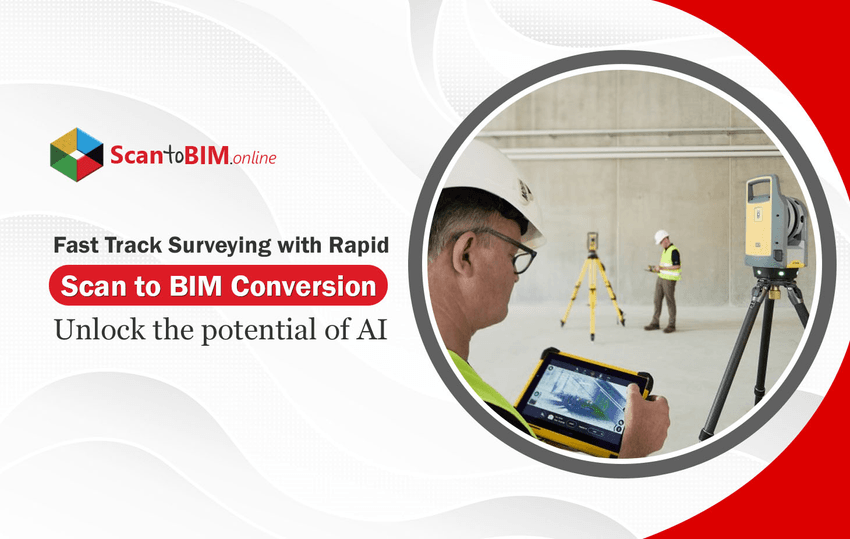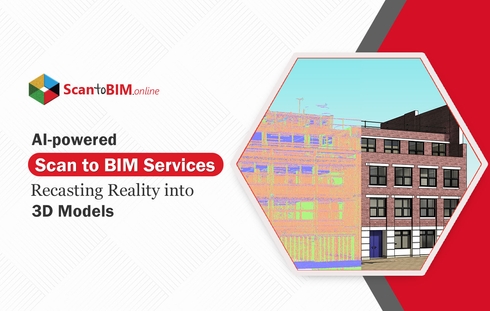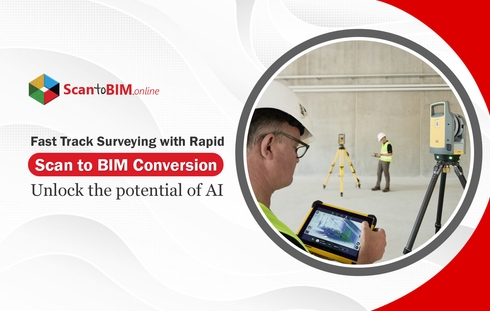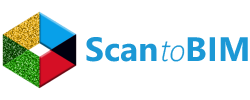
For architectural heritage and dilapidated structures, surveying is a vital step in the redevelopment process. It is common to have technical plans of existing buildings or even digitized computer-aided drawings. Still, an existing BIM model or a 3D model is not the case for such buildings.
To renovate or reconstruct such structures, it is imperative to carry out the reverse engineering process using architectural surveying techniques to obtain the actual constructive conditions of the building.
The Scan to BIM processes are applied to intervene on buildings of historical relevance, propose recovery, redevelopment, or renovation options, keep track of progress on construction sites, and digitize the existing work for facility management.
To develop a better understanding of the Scan to BIM conversion process and the advancements in the field, it is first necessary to understand the key aspects of surveying.
Surveying: A Consequential Stage for Architecture and Engineering Projects
Surveying is a conscious process of understanding the building characteristics with appropriate analysis, synthesis, and documentation of the architectural project. It helps the architects and engineers to develop a better understanding of the project specifications.
The following steps formulate a survey: a preliminary study, possession of documents, carrying out measurements, and finally, the restitution or reconstitution of the project.
Architectural surveying is an intervention for heritage or aging built forms proposed for restoration, resurrection, or redevelopment. For most projects,
Surveying is a vital step for the whole building re-design and construction process, and crucially through the survey data the AEC professionals can decide the further course of action.
The process not only allows the creation of accurate technical construction drawings but also assesses the quantitative and qualitative attributes to make suitable design choices.
Key Aspects of Surveying
The importance of Surveying cannot be overstated in the AEC industry. Let’s look at some of its key benefits-

Explicit Data Extraction:
The successful restoration and redevelopment of projects requires details about every nuance of the existing built form.
The relevant graphic documentation is conducive to a functional design as it constitutes data about structural analysis, mechanical damage, verticality and horizontality of the building, and original geometric layout.
Steer Away from Errors and Oversights:
Surveying identifies and records the nuances of any built form in the most accurate way possible, reflecting on the specific construction situations, the possible reasons behind structural failure, and details about the degradation and erosion of materials, leaving no room for errors or oversights.
Compliance with Codes and Standards:
The detailed site study allows the architects and designers to understand the codes that govern the existing structure and make amendments, ensuring compliance with the latest building codes and standards.
What is Scan to BIM?
Based on the tools and procedures used during the survey, there are various operational methodologies like photogrammetry, planimetric survey, and topographical survey, which can be employed to obtain site details. In addition to these techniques, the latest advancement in the industry is Scan to BIM: surveying with 3D laser scanners.
Laser scanners digitally document the “de facto'' shape and position of the object employing a point cloud technique. Point clouds are a cluster of points spatially positioned according to the x, y, and z coordinate system at the center of the scanner.
Rapid Scan to BIM Conversion: A Preferable Choice for Surveyors and MEP Engineers
The demand for a fast Scan to BIM conversion process is gaining prominence in the AEC industry, aiming to organize space and shape the built environment. The Point cloud to BIM services are increasingly replacing the standard approach in various countries and hold enormous potential for automating the AEC sector. Here are the key factors driving the demand for rapid Scan to BIM services:
- Companies are entitled to meet tight project deadlines to ensure client satisfaction
- Modern projects with complex detailing require precise BIM models in a short period
- Longer conversion translates to higher project costs and potential execution delays.
- Technological advancements pave the way for a rapid conversion process grabbing the attention of AEC professionals.
Speed, Quality, and Affordability: Three Pillars for a successful Scan to BIM conversion
Speed, Quality, and Affordability are the three pillars in the AEC industry for a lucrative Scan to BIM conversion and smooth project delivery. Creating an equilibrium between these pillars results in meeting client expectations and maintaining a competitive edge in the industry.
Let’s delve deeper into the specifics of these pillars:
Speed
- Speed is a critical factor for meeting client demands and achieving desired results, leading to repetitive clientele.
- Quick turnaround time can be a governing factor for a client while deciding on the service provider company.
- AEC firms delivering fast-paced BIM modeling services get a competitive edge in the market.
- Resource allocation and optimization results in increased efficiency and profitability.
Quality
- High-quality BIM models are crucial for accurate planning, design, and construction of projects. Poor quality might lead to errors, rework, and increased commercials.
- Qualitative BIM models provide detailed site representations, inducing accuracy and precision to the results on site.
- Quality-based BIM modeling services form a strong foundation for the client to trust the model with exact site depictions and make informed decisions accordingly.
Affordability
- It is one factor that majorly influences the choice of service provider for an AEC firm.
- Cost-effective services are a preferable choice for any company along with quality and rapid Scan to BIM conversion, as it allows them to offer competitive pricing for project execution on site.
- Efficient costing significantly impacts the labor costs, and overall project expenses, making it a value-for-money deal for a company.
Now, the question that arises is, How can the surveyors and other AEC professionals integrate these pillars into their projects for a rapid and successful Scan to BIM conversion?
Integrating Advanced Technology to Scan to BIM Conversion
The AI-powered Scan to BIM conversion tool by ScantoBIM.Online can be a preferable approach for a 50% faster conversion process. Services offered by VBS can be tailored as per the needs and pain points of the Surveyors and MEP engineers, enhancing their overall experience.
Surveyors and MEP engineers usually face challenges due to various inherent factors that can be dealt with the advanced AI-powered approach. The top-grade quality check tools assess more than 100 aspects of models converted from site scans to ensure the accuracy of the final BIM model.
The tool is a beneficial way to enhance the value of surveying in the AEC market with BIM modeling services of unparalleled quality. The advanced tools and technology can help the surveyors and MEP engineers in 10,000 sq ft conversion every day by an experienced team of 150+ dedicated professionals, specializing in precise Scan to BIM modeling services.
Benefits of Adapting AI-powered Conversion Tool
Scan to BIM is becoming a more advanced and accessible tool for surveying due to technological breakthroughs and emerging trends that simplify the conversion process.
Here are a few benefits of incorporating AI-powered conversion tools into your surveying projects:
Minimum Human Intervention:
The AI-powered approach reduces human intervention in the Scan to BIM conversion process and
Unparalleled Accuracy and Precision:
The in-house plugins reduce the possibility of errors, providing unmatched accuracy and consistency to the Surveyors and MEP professionals. The BIM models are developed according to the industry standard to ensure precise results.
Multiplied Rate of Conversion:
The use of advanced AI tools multiplies the conversion rate, and reduces the processing and modeling time, leading to 50% time savings.
Commercials Reduced to 50%:
The efficient and emerging technology translates to services that reduce the operational expenses of a project and result in 50% cost savings at the end.
Rapid Conversion Success Story
Hale Tip- a company grounded in virtual design and construction, engaged AI-powered conversion tools for 750,000 sq ft of Scan to BIM projects. The BIM model was delivered in 50 days which equates to successfully converting 22,000 sq ft area daily.
The AI tool by VBS not only accelerated the turnaround time for the project but effectively managed substantial survey data, overcoming the skill scarcity. The AI and quality check tools monitored over 100 parameters in the BIM model, and still ensured timely delivery.
Conclusion
Architectural survey methods with 3D laser scanning are capable of registering every nuance of the building with a superior level of accuracy to conventional methods, reducing errors, and minimizing the fieldwork.
The current technological advancements in the industry and the emerging trends have increased the demand for the BIM models as the end product of the site surveys. Scan to BIM services is a new paradigm that still challenges professionals when dealing with old and heritage buildings.
Such scenarios demand adapting to the latest developments in the field such as AI-powered tools and quality check solutions to optimize the process and make reconstruction projects more efficient.








